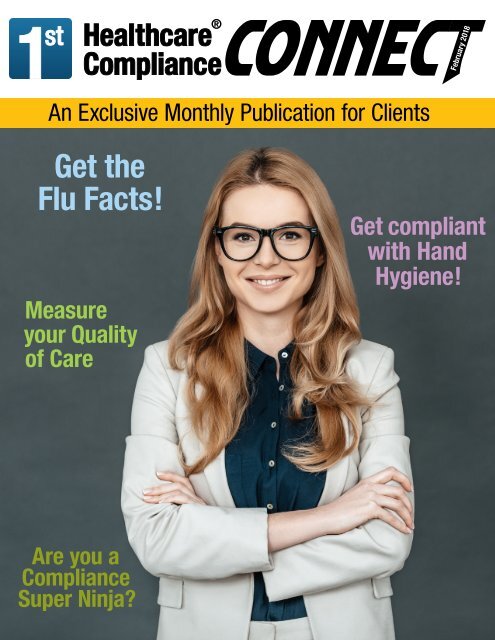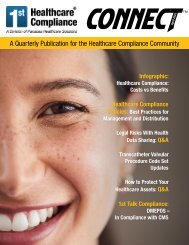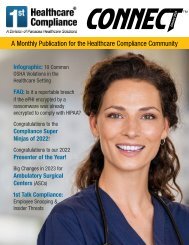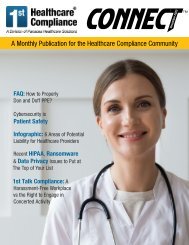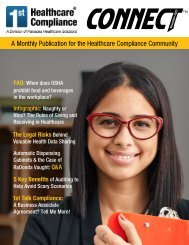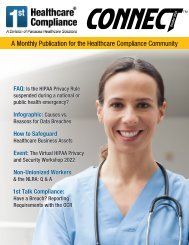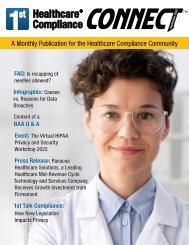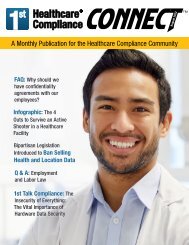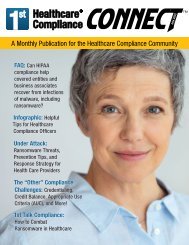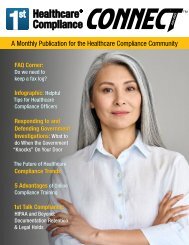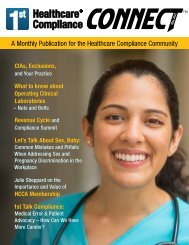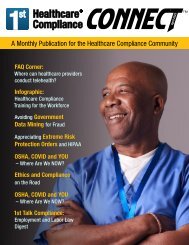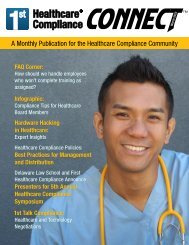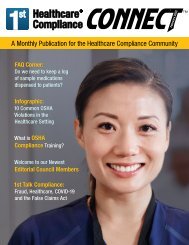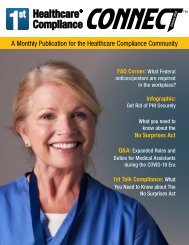First Healthcare Compliance CONNECT- February 2018
Create successful ePaper yourself
Turn your PDF publications into a flip-book with our unique Google optimized e-Paper software.
®<br />
<strong>CONNECT</strong><br />
An Exclusive Monthly Publication for Clients<br />
<strong>February</strong> <strong>2018</strong><br />
Get the<br />
Flu Facts!<br />
Measure<br />
your Quality<br />
of Care<br />
Get compliant<br />
with Hand<br />
Hygiene!<br />
Are you a<br />
<strong>Compliance</strong><br />
Super Ninja?
January<br />
2<br />
January<br />
18<br />
<strong>February</strong><br />
1<br />
March<br />
1<br />
<strong>February</strong> April<br />
1<br />
Important <strong>Compliance</strong> Dates<br />
Starting January 2, <strong>2018</strong>, through <strong>February</strong> 28, <strong>2018</strong>, Critical<br />
Access Hospitals and Eligible Hospitals attest for EHR Incentive<br />
through QNet.<br />
As of January 18, <strong>2018</strong>, WCAG 2.0 AA Website accessibility and<br />
Section 508 compliance for any organization receiving federal<br />
healthcare dollars. MIPS Improvement Activities - accessibility.<br />
Applicable organizations post OSHA 300A information for employees<br />
through April 30, <strong>2018</strong>.<br />
Organizations must report all breaches under 500 for CY2017 by<br />
March 1, <strong>2018</strong>.<br />
April 1, <strong>2018</strong> begins the transition period for claim submissions with<br />
new Medicare Cards. Cards will be mailed to beneficiaries April<br />
<strong>2018</strong>-2019.<br />
<strong>Compliance</strong> Super Ninja<br />
Terri Councilor<br />
Office Coordinator<br />
Gary S. Ruoff D.O.<br />
How would you describe your experience with <strong>First</strong> <strong>Healthcare</strong> <strong>Compliance</strong>?<br />
Our experience has been excellent. The program has worked very well for us and they are good at getting back to us<br />
with information. The training has also been beneficial for us - I don’t have to go searching for it, it’s all right there.<br />
What do you enjoy most about working with your office?<br />
We are a busy office with an exceptional group of people. They are all team players and what we foster within our team<br />
transcends out to our patients. We prioritize consistent availability to our patients through a team effort.<br />
Would you rather be completely invisible for one day or be able to fly for<br />
one day?<br />
I would rather be able to fly for one day. There are a lot of things I haven’t seen<br />
and this way I could take it all in from a different perspective.<br />
July<br />
1<br />
<strong>February</strong> October<br />
1<br />
By July 1, <strong>2018</strong> for organizations with 20-249 employees in high<br />
risk NAICS and ≥250 employees must electronically submit 2017<br />
OSHA 300A form.<br />
By October 1, <strong>2018</strong> Bundle Payments for Care Improvement<br />
Advanced Voluntary Bundled Payment Model.<br />
Each month we highlight one exceptional compliance<br />
professional chosen by our client services team. If our team<br />
notices your compliance chops, you might be the next Ninja!<br />
In This Issue:<br />
Important <strong>Compliance</strong> Dates<br />
<strong>Compliance</strong> Super Ninja<br />
Get the Flu Facts!<br />
How to Prevent Noncompliance with Hand Hygiene<br />
Quality Measurement in Practice with Reid Kiser<br />
System Updates<br />
Conquer Patient Safety Challenges with CRPs<br />
Upcoming Learning Opportunities<br />
2 <strong>First</strong> <strong>Healthcare</strong> <strong>Compliance</strong>, LLC © <strong>2018</strong><br />
Contact Toll Free: 888-54-FIRST 3
4 <strong>First</strong> <strong>Healthcare</strong> <strong>Compliance</strong>, LLC © <strong>2018</strong><br />
Contact Toll Free: 888-54-FIRST 5
By Jill Brooks, MD, CHCO<br />
• High number of opportunities for hand hygiene per<br />
hour of patient care<br />
Self-reported factors<br />
• Handwashing agents cause irritation and dryness<br />
• Sinks are inconveniently located/shortage of sinks<br />
• Lack of soap and paper towels<br />
• Often too busy/insufficient time<br />
• Understaffing/overcrowding<br />
• Patient needs take priority<br />
• Hand hygiene affects healthcare workers relationship<br />
with patient<br />
• Low risk of acquiring infection from patients<br />
• Wearing of gloves/belief that glove use obviates need<br />
for hand hygiene<br />
• Lack of knowledge of protocols/guidelines<br />
• Not thinking about it/Forgetfulness<br />
• No role model from colleagues or superiors<br />
• Skepticism regarding the value of hand hygiene<br />
• Disagreement with the recommendation<br />
• Lack of scientific information on definitive impact<br />
<strong>First</strong> and foremost, a culture of patient safety must be<br />
adopted by the entire organization. Hand hygiene must<br />
be an organization-wide priority. Staff training should<br />
include the importance of hand hygiene in the healthcare<br />
setting and the use of appropriate engineering and<br />
work practice controls. Frequent reminders are always<br />
helpful -signage, staff meetings and emails – to promote<br />
the significance of hand hygiene to the organization and<br />
patient safety. Periodic monitoring of each individual’s<br />
hand hygiene techniques should be incorporated into<br />
the program to achieve success. Individual and organizational<br />
compliance with hand hygiene practices should<br />
be recognized and rewarded, and noncompliance should<br />
be addressed with sanctions. Continuous evaluation of<br />
the organization’s hand hygiene program is necessary to<br />
assess the effectiveness of the program, revising policies<br />
and procedures when necessary to improve compliance.<br />
Need information on proper hand hygiene techniques?<br />
<strong>First</strong> <strong>Healthcare</strong> <strong>Compliance</strong> offers the following<br />
resources for your hand hygiene program and patient<br />
safety posters.<br />
The Centers for Disease Control and Prevention (CDC) reports approx-<br />
Time’s up for each healthcare worker to be aware of their significant<br />
imately 1.7 million health care-associated infections (HAIs) each year,<br />
role in prevention of HAIs with diligent hand hygiene. As of January 1,<br />
many of which are attributed to transmission by health care person-<br />
<strong>2018</strong>, surveyors for The Joint Commission focus on noncompliance<br />
nel. All health care personnel must be compliant with hand hygiene to<br />
prevent avoidable health care- associated infections (HAIs). However,<br />
implementation of a hand hygiene program in a healthcare facility<br />
is only the first step– but that alone will no longer meet compliance<br />
requirements. The Joint Commission’s heightened focus on hand<br />
hygiene this year will require further efforts for both employers and<br />
employees.<br />
It’s been over a decade since The Joint Commission established the<br />
National Patient Safety Goal (NPSG.07.01.01) for healthcare organizations,<br />
requiring compliance with the CDC or World Health Organization<br />
hand hygiene guidelines. Specifically, this NPSG includes the following:<br />
• implement a hand hygiene program<br />
• set goals for improving compliance with the program<br />
• monitor the success of those plans<br />
• steadily improve the results through appropriate actions<br />
with Infection Prevention and Control Standard IC.02.02.02, EP2, citing<br />
accredited programs for any individuals failing to perform hand hygiene<br />
while involved with direct patient care.<br />
<strong>Healthcare</strong> organizations must address any barriers to an effective<br />
hand hygiene program, particularly those that may result in an individual’s<br />
suboptimal or lack of hand hygiene during patient care activities.<br />
According to the CDC’s Guideline for Hand Hygiene in Health-care<br />
Settings, the following factors are associated with poor adherence to<br />
hand hygiene practices:<br />
Observed risk factors<br />
• Physician status<br />
• Nursing Assistant status<br />
• Male Sex<br />
• Working in an ICU<br />
• Working during the week<br />
Join us on Social Media!<br />
System Updates<br />
We are excited to announce new features coming soon to the<br />
1st Premium solution!<br />
• 24/7/365 anonymous hotline to<br />
reduce the risk of whistleblowers<br />
• Additional reporting via secure url<br />
• Secure document upload,<br />
organization, and storage<br />
• Messages, e-mails, and documents<br />
easily distributed to employees for<br />
attestation and documentation<br />
• Incident reporting and management<br />
across the organization with realtime<br />
updates<br />
Since 2004, The Joint Commission citations primarily focused on<br />
organizations demonstrating a pattern of noncompliance, but this is<br />
• Wearing gowns/gloves<br />
• Automated sink<br />
Contact us today and upgrade your solution!<br />
no longer the case.<br />
• Activities with high risk of cross-transmission<br />
6 <strong>First</strong> <strong>Healthcare</strong> <strong>Compliance</strong>, LLC © <strong>2018</strong><br />
Contact Toll Free: 888-54-FIRST 7
Podcast<br />
Get the eBook!<br />
Quality Measurement in Practice with Reid Kiser<br />
Catherine Short, Partnership Marketing Specialist at <strong>First</strong> <strong>Healthcare</strong> <strong>Compliance</strong>, hosts Reid Kiser,<br />
Founder and CEO of Kiser <strong>Healthcare</strong> Solutions, LLC, strategic and business operations consulting<br />
services to healthcare industry stakeholders, for an interactive discussion on “Quality Measurement<br />
in Practice.”<br />
This podcast will provide attendees with an increased understanding of quality measurement so that<br />
they can effectively identify and use measures to improve the quality of care, while keeping in mind<br />
industry’s value-based goals.<br />
When a patient safety incident, medical error or adverse event occurs, patients are<br />
rarely the only victims. Join us to explore the impact on caregivers and understand<br />
the lasting damage to those providers.<br />
®<br />
Objectives:<br />
1. Define quality measurement and today’s drivers of measurement<br />
2. Describe the types of quality measures and practical uses for measures<br />
3. Discuss opportunities to maximize improvement with quality measurement<br />
Looking for the latest compliance insights?<br />
Subscribe to our listen and learn podcasts and don’t miss a thing!<br />
Patient Safety Gaps<br />
Medical Errors and Second Victims<br />
By David M. Sommers MD JD LLM<br />
Read more about:<br />
• Background of Patient Safety Gaps<br />
• Scope of the Problem<br />
• Medical Errors and Accountability<br />
Listen to the <strong>First</strong> <strong>Healthcare</strong> <strong>Compliance</strong> podcast!<br />
Download your copy today!<br />
8 <strong>First</strong> <strong>Healthcare</strong> <strong>Compliance</strong>, LLC © <strong>2018</strong><br />
Contact Toll Free: 888-54-FIRST 9
COMPLIANCE WORD SEARCH<br />
Join us for The <strong>Healthcare</strong><br />
<strong>Compliance</strong> Symposium <strong>2018</strong>!<br />
Thought leaders will provide meaningful insight<br />
on time-sensitive topics including: elements<br />
of a compliance program, HIPAA Privacy and<br />
Security, OSHA, and Human Resources for<br />
compliance. Attendees are eligible to receive CME,<br />
CLE, and CEUs while networking with industry peers.<br />
Register now for Early Bird Pricing!<br />
10 <strong>First</strong> <strong>Healthcare</strong> <strong>Compliance</strong>, LLC © <strong>2018</strong><br />
Contact Toll Free: 888-54-FIRST 11
The most comprehensive healthcare<br />
compliance course yet!<br />
Improving patient safety, decreasing rates of error, and minimizing<br />
medical liability costs are important objectives of health care reform<br />
in the United States. Many experts believe that to accomplish these<br />
goals, organizations must adopt principles of transparency and just<br />
culture, and engage in effective and honest communication with<br />
patients and families as well as proactively seek early resolution of<br />
claims after adverse events caused by inappropriate care. In recent<br />
years, forward-thinking health systems and liability insurers have<br />
developed communication and resolution programs (CRPs) designed<br />
to encourage full disclosure of unintended patient care outcomes to<br />
patients and their families. Such efforts involve an investigation of the<br />
incident, an apology, an explanation with complete revelation of the<br />
facts, and when appropriate, reimbursement or compensation. These<br />
programs represent a systematic strategy to respond to patients when<br />
something goes awry, and are integral to patient quality and safety. In<br />
part, they are founded on the principles of respect, transparency, and<br />
honesty and may improve patient safety outcomes and quality of care<br />
by providing an introspective review of the occurrence and promoting<br />
learning opportunities from any mistakes, errors, or near misses. CRPs<br />
meet the needs of patients, their families, and caregivers when an<br />
adverse event occurs in patient care, and address any identified patient<br />
safety and quality gaps.<br />
Alternatives to Medical Malpractice Litigation<br />
Many patient safety leaders view these programs as an alternative<br />
to the costly and lengthy malpractice litigation process which fails to<br />
answer fundamental questions about the nature of the harm and basic<br />
details of the incident. Often, the traditional response to patient harm<br />
involves the disclosure of limited information and avoidance of admissions<br />
of fault–a “deny and defend” model. These interactions quickly<br />
turn adversarial, and the open communication normally accorded the<br />
patient-physician relationship is abandoned. For health care providers,<br />
the “deny and defend” paradigm provides little incentive for investigation<br />
of the event because of the fear that a compensable error might<br />
be revealed. Thus, there is no analysis of the event and organizations<br />
are unable to learn how to prevent a similar catastrophe. This loss of a<br />
learning opportunity can derail efforts to improve patient care.<br />
One of the seminal communication and resolution programs was<br />
developed and implemented at the University of Michigan Health<br />
System (UMHS). This “Michigan” model and other programs, mostly<br />
notably the “Seven Pillars” approach at the University of Illinois Medical<br />
Hospital and Health Sciences System (“UIH”), changed the way these<br />
organizations responded to patient injuries and medical malpractice<br />
claims. These programs are known collectively as early settlement<br />
models as opposed to another model involving limited reimbursement,<br />
which typically covers nominal out-of-pocket expenses and loss<br />
of time, and may adjust the billing for services. UMHS’s efforts were<br />
driven by three guiding principles: (1) compensate quickly and fairly,<br />
(2) vigorously defend appropriate care, and (3) reduce patient injury<br />
and claims by learning from mistakes. The health system sought open<br />
communication with patients about an adverse event but also critically<br />
investigated the incident to assess whether the care comported<br />
with the standard of care and was reasonable, offered an apology, and<br />
provided an early offer of compensation when the care fell below the<br />
standard of care or was unreasonable in the circumstances. A multidisciplinary<br />
internal committee reviews the event to determine if the care<br />
provided was medically reasonable and whether the care negatively<br />
affected the outcome. If warranted, peer review, quality improvements,<br />
or additional education and training may be recommended. This program<br />
has successfully reported a reduction in claims, malpractice<br />
lawsuits, median time to claim report to resolution, defense costs, and<br />
average settlement amounts.<br />
UIH adopted a related approach premised upon similar underlying principles<br />
as well as the CANDOR program (communication and optimal<br />
resolution program developed by the Agency for <strong>Healthcare</strong> Quality<br />
and Research). The “UIH’s Seven Pillars” strategy is characterized<br />
by prompt reporting of the incident, rapid review and investigation by<br />
safety and risk management, early communication with patient and<br />
family (within 15-30 minutes of the unanticipated event), full disclosure,<br />
apology, and a rapid remedy (holding hospital and professional<br />
fees), a focus on learning opportunities and system improvement, data<br />
tracking and evaluation, and education and training. The results of this<br />
program have been profound. Having open and honest communication<br />
with patients and their families and offering an early financial resolution<br />
package after an adverse event has not resulted in significant<br />
liability concerns but has actually led to lower claims, legal fees and<br />
expenses, costs per claim, settlement costs, self-insurance costs, and<br />
mean times to claim closure. These findings closely track the UMHS<br />
experience.<br />
The Fundamentals is a user-friendly, four-module course designed<br />
to help healthcare professionals understand the<br />
essential principles and practices of compliance.<br />
Visit 1sthcc.com/shop to<br />
register today!<br />
Written by our “dream team” of<br />
healthcare providers and attorneys,<br />
The Fundamentals Course is packed<br />
with useful, easy-to-understand<br />
information that covers HIPAA, OSHA,<br />
employment law and enforcement of<br />
Federal healthcare laws. The course<br />
takes less than four hours to complete.<br />
The <strong>Compliance</strong> Certification Board<br />
(CCB)® has approved this event for up<br />
to 4.4 non-live CCB CEUs.<br />
12 <strong>First</strong> <strong>Healthcare</strong> <strong>Compliance</strong>, LLC © <strong>2018</strong><br />
Contact Toll Free: 888-54-FIRST 13
Join Us for These Upcoming<br />
Learning Opportunities!<br />
Complimentary CEU Webinars<br />
<strong>February</strong> 20th @ 12pm ET<br />
Sexual Harassment in the #MeToo Era: What<br />
You Need to Know to Protect Your Business<br />
Lauren E.M. Russell, Esq.<br />
Young, Conaway, Stargatt, and Taylor, LLP<br />
Listen and Learn Podcasts<br />
March 6th @ 12pm ET<br />
Trendspotting- False Claims Act<br />
Enforcement in Health Care<br />
Sean McKenna, Esq. and<br />
Michael McCarthy, Esq.<br />
Featured <strong>February</strong> 12th<br />
Quality Measurement in Practice<br />
Reid Kiser<br />
Kiser <strong>Healthcare</strong> Solutions, LLC<br />
Featured <strong>February</strong> 27th<br />
Medical Waste FAQ<br />
Matt Georgov<br />
ChoiceMed Waste<br />
Now available in our training zone!<br />
CEUs from the following organizations:<br />
AAPC<br />
ADCA<br />
AHCAE<br />
AHIMA<br />
APMBA<br />
ARHCP<br />
HBMA<br />
MAB<br />
NAMAS<br />
NHCLA<br />
PAHCOM<br />
PAHCS<br />
PHIA<br />
PMI<br />
PMRNC<br />
POMAA<br />
Contact our Client Services Team with any questions!<br />
888.54.FIRST or clientservices@1sthcc.com<br />
14<br />
<strong>First</strong> <strong>Healthcare</strong> <strong>Compliance</strong>, LLC © <strong>2018</strong>


